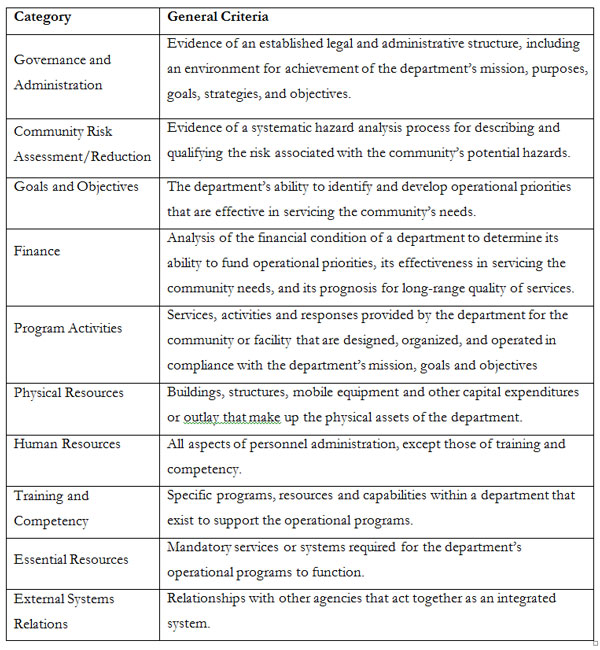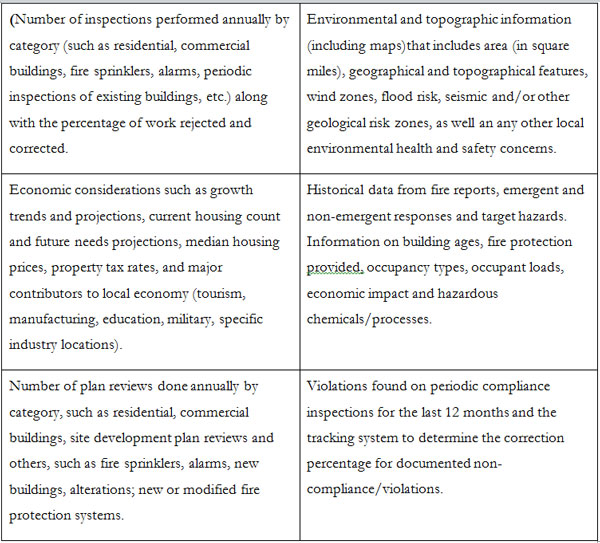By Robert Neale
What do the fire prevention bureaus for the state of Florida and the village of Tinley Park, Illinois, have in common?
Currently, they are the only jurisdictions in the United States recognized by the International Accreditation Service (IAS) as fully accredited fire prevention and life safety departments. Accreditation is formal third-party recognition that demonstrates the two organizations fulfill specific performance requirements and are competent to perform their regulatory tasks.
By becoming accredited, the two agencies lead the U.S. in global recognition of their work. Accreditation demonstrates to their residents, customers, and taxpayers they are getting the highest quality service as identified by a leading panel of fire protection and code compliance experts.
Why Should my Agency be Accredited?
Florida State Fire Prevention Bureau Chief Casia Sinco said the accreditation process “has been a very valuable and rewarding experience for the entire staff. The most beneficial thing is we knew we are doing things well, but this gives the means to validate it. We have taken on some new challenges trying to improve our documentation and quality standards.”
Asked what impact accreditation has had on its customers, Chief Sinco said, “the average citizen may not know–because we serve such a diverse, statewide population–but it has given us a greater visibility with regard to our governing body. We report to an elected official, the Chief Financial Officer of Florida, and this has given us more visibility in that respect.”
Chief Sinco recommended the accreditation process to any organization that, in her words, “wants to go to the next level, to improve on processes and validation. It makes you take a long, hard long look at who you are, what you do, and why you do it.” She added that there was value in the introspective approach the process uses because it developed employee involvement at much greater level, bringing staff and management together to see standards and to see the resulting policy and procedures.
Tinley Park Fire Marshal Daniel Riordan echoed Sinco’s comments. The greatest outcome, he said, was the credibility accreditation established with other village administrative and elected officials. “Now,” he said, “when we say something, it’s not just [the fire marshal] talking, they know we have been reviewed by an independent evaluator that knows how things should be”.
Riordan added that throughout the accreditation review the Tinley Park Fire Department knew it was doing some things well with its day-to-day processes, but “putting pen to paper” as a part of the accreditation process made the organization rethink some of its past practices to see where improvements could be made.
Agencies that have been through accreditation processes of all kinds report it is a valuable exercise to identify their existing strengths and areas where improvements are needed. Even if an organization does not reach accredited status, the data collection and analysis work gives the agency the information it needs to assess performance.
What is the IAS?
The IAS, part of the International Code Council (ICC) Family of Companies, is an organization that promulgates the development of accreditation criteria through an open public hearing process and — through its on-site evaluation efforts — provides objective evidence that an organization operates at the highest level of ethical, legal, and technical standards. Based in Brea, California, IAS is a nonprofit, public-benefit corporation that has been providing accreditation services since 1975. IAS accredits a wide range of companies and organizations including governmental entities, commercial businesses, and professional associations. IAS accreditation programs are based on recognized national and international standards that ensure domestic and/or global acceptance of its accreditations.
IAS accredits building departments, third-party building department service providers, special inspection agencies, product certification agencies, inspection programs for metal building manufacturers, fabricator inspection programs, testing and calibration laboratories, training agencies, curriculum developers, and field evaluation bodies. IAS’s Fire Prevention and Life Safety Department accreditation program began in 2011.
Certification or Accreditation?
How is accreditation different from certification? The fire service is familiar with certification programs. Certification typically applies to a single person and the performance requirements needed to fulfill job duties. Individuals are certified as being able to competently complete a job or task competently, usually by passing an examination. ICC Certified Fire Marshal, Fire Inspector and Fire Plans Examiner certifications, National Fire Protection Association professional qualifications, emergency medical technician training, hazardous materials technician training, and similar programs certify individuals to do their jobs.
Accreditation is a process where an organization or agency is assessed by an independent entity that compares the agency’s performance against consensus criteria. The organization must produce plans and documentation that it meets the accrediting agency standards and commit to ongoing review to retain the accreditation.
How are accreditation criteria set? The criteria are developed following public hearings conducted by the IAS Accreditation Committee. The Accreditation Committee was established by IAS to monitor and govern its accreditation programs. Committee meetings are modeled on a public hearing process that provides input from all interested parties and transparency to IAS programs, activities, and accreditation criteria. IAS Committee hearings run live on the Web to allow for larger participation.
The fire prevention bureau criteria are outlined in the IAS document Accreditation Criteria for Fire Prevention and Life Safety Departments (AC426). ). IAS has a Technical Advisory Council (TAC-Fire Prevention) chaired by Chief Ronny J. Coleman of Elk Grove, California. The TAC helped develop the accreditation criteria, which were then approved pursuant to an Accreditation Committee hearing. The Center for Public Safety Excellence, Inc. (CPSE) is partnering with IAS to develop training tools for departments interested in learning about the criteria to become IAS-accredited. CPSE is well-known to the fire service for its certification and accreditation efforts among U.S. fire departments.
The accreditation committee is appointed by the IAS Board of Directors and comprises individuals from a cross section of U.S.-based regulatory officials (including some from the fire service), subject matter experts, and individuals from the global community.
How Do I Get My Agency Accredited?
The accreditation process is robust, and starts with a commitment from the fire chief, director of the fire prevention bureau, and other agency staff. The accreditation program, which includes on-site review by an IAS assessment team, will evaluate departments against the performance requirements in 10 primary categories. Table 1 summarizes the areas that are evaluated for each agency.
Table 1. Areas Evaluated under the Accreditation Criteria for Fire Prevention and Life Safety Departments (AC426)

Within these categories, there are specific requirements that must be met to satisfy the accreditation criteria. For example, agencies being evaluated must have:
- A method of selecting the fire prevention department head that uses qualifications and credentials.
- Documented procedures to record, investigate, and resolve complaints against the department or complaints about contractors, work without permits, and similar violations.
- A process by which risks are defined and department goals for mitigation are established.
- Documented service goals, established with stakeholder input, for each area of service provided by the fire prevention and life safety department.
- A matrix of certifications required by the department for staff including names, job titles, required certificates, current standings, and expiration dates[1].
The bulleted list is not exhaustive. There are many additional requirements in Accreditation Criteria for Fire Prevention and Life Safety Departments (AC426) that must be met to earn the recommendation. There also is a substantial amount of data that must be collected and presented to the IAS team to verify the agencies’ historical performance. Table 2 provides a summary of some of the documentation that must be submitted.
Table 2: Required Documentation Examples*

*Table 2 represents only a sample of the data required for review. Refer to Accreditation Criteria for Fire Prevention and Life Safety Departments (AC426) for the complete list.
The Site Visit
The process includes l IAS team visits to the organization that wants to be accredited. Prior to scheduling the full on-site evaluation, IAS will schedule a two-day visit by the lead evaluator and a subject-matter expert(s) to review and comment on the applicant’s degree of compliance with AC426.
A team of trained evaluators and subject-matter experts, including an IAS-approved evaluation team leader, visits the department being considered for accreditation to conduct a thorough review of the department and the services it provides. The evaluation team interviews leadership–such as the mayor, city manager, city attorney, fire chief, or county administrator– other department heads, staff, and stakeholders.
Evaluators and subject-matter experts assigned to evaluation teams are screened by IAS to ensure there is no potential conflict of interest with the applicant. Former employees or individuals who may have provided consultant services to the agency are prohibited from participating in the evaluation. The evaluation team may identify corrective measures that must be accomplished before the department is recommended for accreditation.
In some cases, the team leader may recommend to the IAS Chief Technical Officer that a follow-up evaluation occurs to verify implementation of corrective measures taken by the applicant in response to the full evaluation. Typically, follow-up evaluations include the team leader and another member for one or two days on-site.
Once the team leader indicates, through documented evidence, that the jurisdiction is in full compliance with the acceptance criteria, the agency is given a final review by the IAS Accreditation Review Committee during a scheduled hearing. A formal accreditation certificate is issued to the jurisdiction when the review committee grants its approval.
To sustain its IAS accreditation, the agency must remain in compliance with the accreditation criteria at all times and submit periodic audit reports to IAS. The accreditation period lasts three years before another on-site evaluation is performed.
Individual certification and agency accreditation in fire prevention and life safety are the way of the future. Architects, builders, developers, individuals, and those who use the fire prevention bureau’s services want to be assured they are getting quality and consistency for the price they pay. Certification and accreditation provide independent proof that individuals and their organizations are striving to do the best they can.
For more information on the Fire Prevention and Life Safety Department Accreditation program visit the IAS Web site (www.iasonline.org/PDF/AC/ac426.pdf ) or call IAS at 1-866-427-4422.
[1] Certifications must be from a national construction code promulgation organization, such as the International Code Council, the National Fire Protection Association, or other acceptable certification organization, as determined by local ordinance or state laws.
Robert Neale serves as the International Code Council Vice President for Government Relations: National Fire Service Activities. He is responsible for strategic guidance to help local fire organizations adopt and enforce the most recent version of the model codes based on technical merit and build relationships among code enforcement entities.
In 2015, Rob retired as Deputy Superintendent for the United States Fire Administration National Fire Academy in Emmitsburg, Maryland. Prior to that, for six years he managed the National Fire Academy’s Technical Fire Prevention curriculum; including fire inspection techniques, prescriptive and performance-based fire and building code interpretation and application, fire protection systems function, design, installation, and standards, and plan review for fire inspection personnel.


